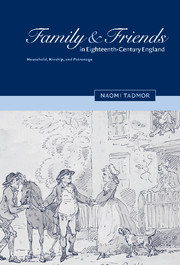Book contents
- Frontmatter
- Contents
- Acknowledgements
- A note on the text
- List of abbreviations
- Introduction
- 1 The concept of the household-family
- 2 The concept of the household-family in novels and conduct treatises
- 3 The concept of the lineage-family
- 4 The language of kinship
- 5 Friends
- 6 Political friends
- 7 Ideas about friendship and the constructions of friendship in literary texts
- Conclusion
- Bibliography
- Index
2 - The concept of the household-family in novels and conduct treatises
Published online by Cambridge University Press: 30 July 2009
- Frontmatter
- Contents
- Acknowledgements
- A note on the text
- List of abbreviations
- Introduction
- 1 The concept of the household-family
- 2 The concept of the household-family in novels and conduct treatises
- 3 The concept of the lineage-family
- 4 The language of kinship
- 5 Friends
- 6 Political friends
- 7 Ideas about friendship and the constructions of friendship in literary texts
- Conclusion
- Bibliography
- Index
Summary
Introduction
It is clear that Thomas Turner used the concept of the household-family not only because it made sense to him personally, but because it made sense in the context of the world in which he lived. Furthermore, the comparative examples discussed at the end of chapter 1 show that this concept was known and understood throughout the eighteenth century. Nevertheless, any research based primarily on a single source is bound to raise the question of ‘representativeness’. Additional test-cases must be explored. It is important, moreover, to go beyond individual examples and study test-cases with systematic care. This is the aim of the present chapter. This chapter will present a detailed analysis of the concept of the household-family in four mid-eighteenth-century texts: two novels and two conduct treatises. The two novels are Richardson's Pamela: or, Virtue Rewarded and Haywood's The History of Miss Betsy Thoughtless. The conduct books are The Apprentice's Vade Mecum: or, Young Man's Pocket-Companion, a conduct treatise for apprentices by Samuel Richardson, and A Present for a Servant-Maid, a conduct treatise for servant-maids, by Eliza Haywood.
These texts offer us additional verbal usages and they also take us from the realm of the personal diary to a much more public arena. Conduct books and novels were well-known genres in the eighteenth century. These specific texts were also written by popular authors and were widely circulated.
- Type
- Chapter
- Information
- Family and Friends in Eighteenth-Century EnglandHousehold, Kinship and Patronage, pp. 44 - 72Publisher: Cambridge University PressPrint publication year: 2001

